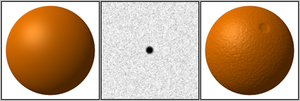Bump mapping
Bump mapping is a technique that is used in 3D visualization programs to improve the richness of detail in objects without increasing their geometry complexity. The trick is that the information you need is stored in a texture that is used to draw shadows on a surface.
Bump mapping is therefore only an (albeit effective) illusion that simulates surface irregularities that are not present in the geometry of the model.
It improves image quality and the level of realism without significantly affecting the time it takes to render . In addition, the field of application is not limited to shades. Reflections can be treated the same way with this technique. Bump mapping already plays a major role in entertainment industry projects, as the visual quality can be significantly improved without significantly affecting performance.
A prerequisite for using bump maps is a lighting model based on per-pixel lighting . APIs like DirectX or OpenGL already have the necessary routines. Mostly, however, a combination of vertex and pixel shaders is used to precisely control the required effects.
The process was developed in 1978 by James F. Blinn .
Height mapping
The relative height information is available in a texture in the form of gray levels - the so-called heightmap . Each gray value stands for a certain height. Normally black (value 0) is the “lowest” point and white (value: 255) the “highest”. This form of data storage is not limited to bump mapping, it is used much more often to generate huge terrains.
Since height differences are only fooled by different shades of gray on the texture, but the surfaces remain smooth, some visible errors occur:
- The structure appears heavily distorted when viewed from a flat angle.
- The silhouette remains as flat as the original object.
- A smooth shadow is cast.
- Bumps don't cast shadows on each other.
application
- Texture baking
The 3D modeller builds two versions of a model: a high-resolution, very detailed (100,000+ polygons ) and a non-detailed (100-10,000 polygons ) intended for the finished program. A program calculates the difference between the two models and uses the data obtained to describe a texture. This texture is then stretched onto the low-poly model. In the finished game / picture / application, the user gets the impression that the highly detailed model is being used.
- Creating by hand
In the case of simple shapes (cracks, highlighted text) and details that also appear in a hand-made color texture (flaked paint, flaws, rivets), a bump map is often created by hand by highlighting or highlighting the desired areas with light and dark shapes and lines deepened, or the color texture is edited and converted to gray levels so that the desired effect is achieved.
See also
Web links
- Bump Mapping (Engl.)


